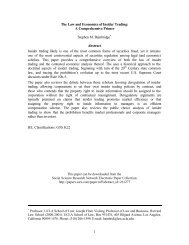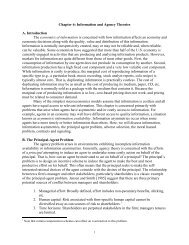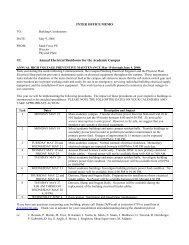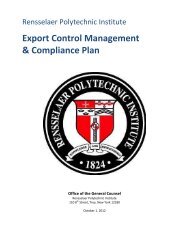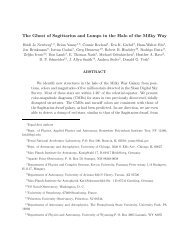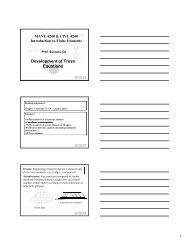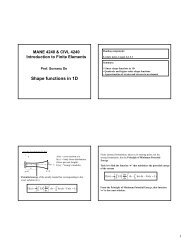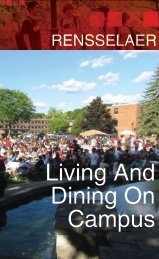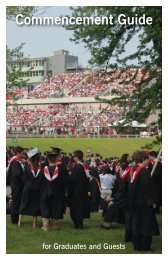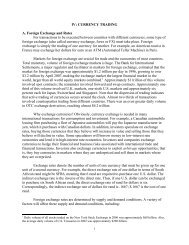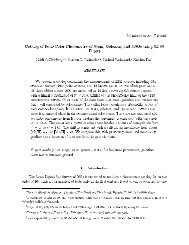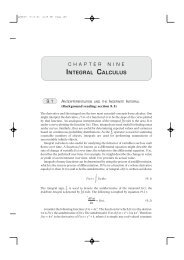Quiet Crisis - Building Engineering and Science Talent
Quiet Crisis - Building Engineering and Science Talent
Quiet Crisis - Building Engineering and Science Talent
Create successful ePaper yourself
Turn your PDF publications into a flip-book with our unique Google optimized e-Paper software.
Dr. Bush's report, <strong>Science</strong> –The<br />
Endless Frontier, made the case<br />
for long-term national investment<br />
in scientific research <strong>and</strong><br />
education in the interest of the<br />
future well-being of the United<br />
States. “Scientific progress,”<br />
wrote Dr. Bush, “is one essential<br />
key to our security as a<br />
nation, to our better health, to<br />
more jobs, to a higher st<strong>and</strong>ard<br />
of living, <strong>and</strong> to our cultural<br />
progress.” Progress to this<br />
end, according to Dr. Bush,<br />
required a partnership with<br />
what became today’s research<br />
universities, through support<br />
of basic research, <strong>and</strong> especially<br />
through the education<br />
<strong>and</strong> training of a scientific<br />
workforce.<br />
The success of the effort that followed became a model replicated<br />
several times whenever the nation perceived that its<br />
security might be compromised. When Cold War tensions<br />
arose in the late 1940s, President Harry Truman reiterated the<br />
critical role of science in defense of our national security <strong>and</strong><br />
the arms race. A decade later, in 1957, the Soviet Union<br />
launched the first earth satellite, Sputnik. Propelled not only by<br />
the arms race but also a space race, the nation rallied behind<br />
science <strong>and</strong> mathematics education as never before, focusing<br />
its efforts on nurturing youthful talent. So encouraging was the<br />
atmosphere that President John F. Kennedy, in 1961, set a goal<br />
of l<strong>and</strong>ing man on the moon by the end of the decade — a challenge<br />
the nation met, in 1969, with the Apollo 11 mission.<br />
The renewal of a post-Cold War threat to U.S. interests has<br />
sharpened the national focus on issues related to the scientific<br />
workforce. Federal government <strong>and</strong> quasi-government agencies<br />
including the National Research Council (NRC), the<br />
National <strong>Science</strong> Foundation (NSF), the National Academy of<br />
<strong>Science</strong>s (NAS), <strong>and</strong> the Government/University/Industry<br />
Research Roundtable (GUIRR) have studied the issue <strong>and</strong> are<br />
calling for action.<br />
Our Educational Foundation Needs Support<br />
A growing number of university leaders have acknowledged<br />
their responsibilities toward improving a pre-K through 12<br />
Millions of New Jobs<br />
2<br />
1.5<br />
1<br />
0.5<br />
0<br />
Six Million Job Openings Are Projected for Technically Trained <strong>Talent</strong><br />
Projected Number of Job Openings by Technical Field, New Jobs, <strong>and</strong> Net<br />
Replacements, 1998-2008<br />
Computer,<br />
Mathematical<br />
<strong>and</strong> Operations<br />
Research<br />
Medical<br />
Professionals<br />
Health<br />
Technicians<br />
Engineers<br />
<strong>Engineering</strong><br />
& <strong>Science</strong><br />
Technicians<br />
<strong>Engineering</strong><br />
& <strong>Science</strong><br />
Managers<br />
Medical<br />
& Health<br />
Service<br />
Managers<br />
Life<br />
<strong>Science</strong>s<br />
mathematics <strong>and</strong> science feeder system that does not measure<br />
up to the nation’s needs. They are joined in this arena by major<br />
foundations <strong>and</strong> corporations that recognize the scale of the<br />
challenge <strong>and</strong> are ready to do their part in meeting it.<br />
This change in national mood opens up a rare opportunity for<br />
<strong>Building</strong> <strong>Engineering</strong> <strong>and</strong> <strong>Science</strong> <strong>Talent</strong> (BEST), the public-private<br />
partnership that was incorporated a week before the<br />
attacks on the Pentagon <strong>and</strong> the World Trade Center. The establishment<br />
of such a partnership had been proposed a year<br />
earlier in the L<strong>and</strong> of Plenty report. BEST’s three-year mission<br />
is to develop <strong>and</strong> execute a national action plan to increase the<br />
participation of the “under-represented majority” — women,<br />
minorities, <strong>and</strong> persons with disabilities — in technical fields.<br />
BEST Can Help Overcome the <strong>Quiet</strong> <strong>Crisis</strong> in<br />
Several Important Areas<br />
Physical<br />
Scientists<br />
Source: Bureau of Labor Statistics, www.bls.gov<br />
Best Practices The nation needs to know what is really working<br />
in elementary <strong>and</strong> high school mathematics, freshman<br />
physics <strong>and</strong> chemistry, graduate schools, <strong>and</strong> corporate R&D<br />
teams to develop — <strong>and</strong> draw upon — the talent of under-represented<br />
groups. The same wheels are being re-invented <strong>and</strong><br />
the same mistakes made on a daily basis in every part of the<br />
country. Authoritative, readily accessible information on bestin-class<br />
<strong>and</strong> exceptionally promising programs, lessons from<br />
5



